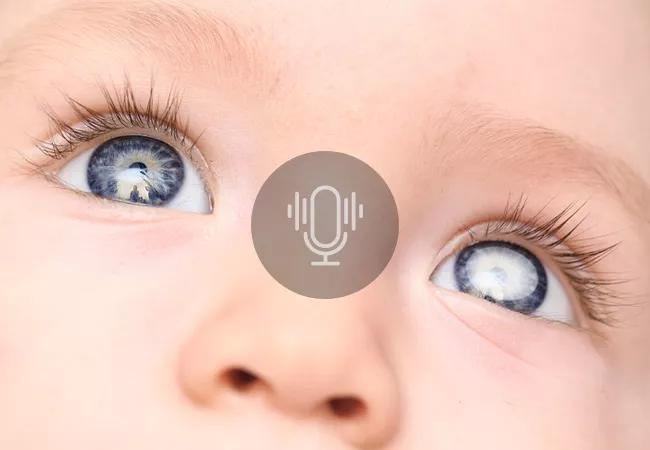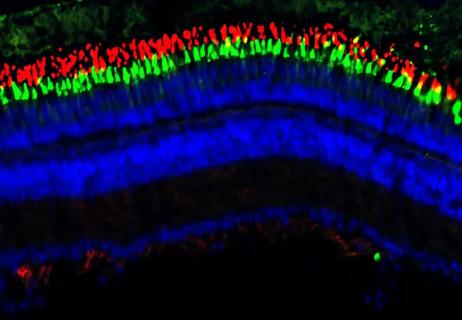Leukocoria is the most common symptom of this rare childhood eye cancer

Advertisement
Cleveland Clinic is a non-profit academic medical center. Advertising on our site helps support our mission. We do not endorse non-Cleveland Clinic products or services. Policy
Eyeshine in humans is largely an artifact of a photography flash. However, its look-alike condition, leukocoria (Greek for “white pupil”), can be a symptom of various diseases, including retinoblastoma.
This malignant tumor is rare, with only about 250 new cases per year in the U.S., and seen exclusively in children.
Leukocoria, which can be due to a growth inside the eye, is the most common presenting symptom in children with retinoblastoma, says Arun D. Singh, MD, Director of Ophthalmic Oncology at Cleveland Clinic Cole Eye Institute. Dr. Singh and hematologist/oncologist Stacey Zahler, DO, of Cleveland Clinic Children’s, explain more about the diagnosis and treatment of the disease in a recent episode of Cleveland Clinic’s Cancer Advances podcast.
“A pediatrician may notice the abnormal pupillary reflex during a well-child exam,” says Dr. Singh. “They won’t see the normal red reflex when they shine a light in the child’s eye. Sometimes parents notice a little glint in the pupil that they ask about when they see the pediatrician.”
Ultimately, patients are referred to an ophthalmic oncologist for diagnosis.
“We conduct a thorough exam of the child under anesthesia,” says Dr. Singh. “We can confirm the diagnosis with ultrasound and other ancillary studies, but we typically don’t do biopsies. It’s mostly a clinical diagnosis.”
All retinoblastoma tumors are caused by a mutation in the RB1 gene. The mutation arises in an undifferentiated cell, a cell that has not fully matured. That’s why the malignancy occurs only in an immature retina.
Advertisement
“Usually, the retina fully matures by age 5,” says Dr. Singh. “As the cells mature, they lose their capacity to become malignant. As a result, retinoblastoma occurs only in children, typically younger than age 5.”
When the disease is due to a germline mutation, it tends to be bilateral. Patients can have multiple tumors in both eyes.
“One patient we recently treated had 10 tumors among the two eyes,” he adds.
Unlike other tumors, retinoblastoma is not treated with external beam radiation therapy. Children with the disease caused by a germline mutation can get second, potentially lethal, tumors resulting from the radiation.
Enucleation is the mainstay of treatment, especially when there is no vision potential in the eye. Chemotherapy is an option if the tumor is not advanced and there is potential for vision.
“Most of the time, focal therapies are needed in addition to systemic chemotherapy,” says Dr. Zahler. “Retinoblastoma is typically a localized solid tumor, so focal therapies are successful. Most patients that are cured of retinoblastoma in the U.S. have had focal therapies.”
Recent advances in drug delivery have led to the use of chemotherapy injections into the eye. In addition, chemotherapy can be administered into the ophthalmic artery. With help from an interventional neurosurgeon, a catheter is inserted through the femoral artery, up through the carotid artery and into the ophthalmic artery, where small doses of chemotherapy are injected into the back of the eye.
Local control rates are high, nearly 100% after enucleation and approximately 75% after chemotherapy, estimates Dr. Singh.
Advertisement
“In the U.S., we have an approximately 97% cure rate for retinoblastoma,” he says. “The risk of death from metastasis is very, very low — maybe five to 10 cases in the U.S. per year.”
However, in some cases, the germline mutation puts patients at risk for other malignancies, such as pineoblastoma in childhood (trilateral retinoblastoma), and osteosarcoma, melanoma and breast cancer later in life.
Caring for children with retinoblastoma requires a team approach. Cleveland Clinic’s Retinoblastoma Center provides patients and families a single point of access to all specialists, including pediatric oncology, pediatric ophthalmology, interventional neurosurgery and genetic counseling. Children receive a whole-patient approach to care, including from a comprehensive psychosocial team — with child life services including music, art and pet therapies; pediatric social work; and pediatric psychology.
“Patients usually start with a nurse coordinator, who supports them through the long course of care,” says Dr. Singh. “We try to offer care all in one place, so families don’t need to return for multiple appointments in various locations, reducing their burden of treatment.”
Genetic counseling is standard for each patient with retinoblastoma. Genetic counselors help interpret test results and advise families of what they could mean for the patient’s siblings and other family members. When a germline mutation is detected, Dr. Singh examines the patient’s siblings as well.
Following treatment and surveillance, patients join Cleveland Clinic Children’s oncology survivorship program. They also return for lifelong yearly monitoring at the Retinoblastoma Center.
Advertisement
Advertisement

The advanced stage of diabetic retinopathy is among the most challenging for retinal surgeons

How to screen for and manage treatment-triggered uveitis

Researchers to study retinal regeneration in zebrafish with new grant from National Eye Institute

Registry data highlight visual gains in patients with legal blindness

Quality improvement project addresses unplanned extubation

Study is first to show reduction in autoimmune disease with the common diabetes and obesity drugs

Specialized clinic provides comprehensive care for pediatric patients with a high-risk history

How one simple project changed the conversation about care and the patient-parental experience